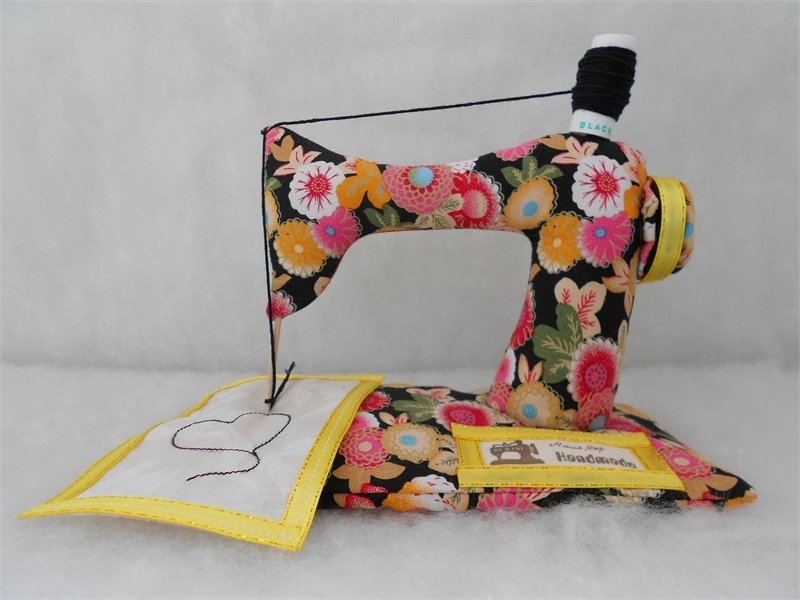Application like clothes finishing is usually complemented by embroidery. For it is used on different structure and quality of material and several types of seams. Even in a single product, you can use a variety of materials and methods for their treatment. Monochromatic loosely woven in most cases the trim cut from the printed fabric colors constitute one rim, ornament, a group of several colors or used as separate elements. Sew them on the car, tucked edge slices and decorate them with hand stitching: a loop, chain-like, goats, etc...

Work description
For application to the products from the dense woolen fabrics (including tweed, bouclé, curl, broadcloth and t. D.), Combined with the knitting, as well as manual knitwear and machine-knitted using a greater variety of materials: fabrics, leatherette, separate elements connected, crocheting or lined with related cords. All this can be supplemented by embroidery.
Appliqué can be performed in the tone of the product, using two to three harmonizing colors or, on the contrary, make it a contrasting, vibrant, especially in products for winter sports.

But in any case the application, as well as any finishing, should organically fit into the clothing ensemble. Technique application. Selected materials, should be moved to a selected pattern finish on the finished product or part (it is easier to use) and sew it to the contours of contrasting string suture needle forward. Of thick paper to prepare a pattern of individual elements, flowers, leaves, emblems and the like. D. and it cut out material for the application.
If we translate the figure in the part or the product is not possible, it is transferred to the tissue paper that prick in the place reserved for the application.

Attach a cut appliqué elements on corresponding places pattern seam needle forward and embroider additions (stems, individual strokes and so on. D.). The paper was then removed and applied to the pressed fabric pattern elements. Pre-processing and execution of the individual elements of application may be different.
types of applications
pattern element - a flower, a cut from tissue treated as follows:
- Cloth (preferably cloth) tack to the base and sew on the wrong side (of the flower contour) simple thread to match the product shirts, thick stitches prihvatyvaya fabric appliqué. On the front side of a loop sewn seam stamen tissue of the wound or their embroider. Stems and veins on the sheets embroidered seam stalk. Thus operate all marks. Usually this method trim baby items, bags, gloves and so on. D.

- picture element line of cut sheathing a loop or tie the suture thread hook tone to the article or trim. Sew to the base of the contour of the same thread. Through-stitches to sew stamens of tissue (on center through the edge rays - stitches will be pressed against the edge). Thus prepared and sutured and other elements of the drawing. Veins on the leaves and flowers embroidered seam stalk, stems as well, only two lines.
- Embroider circuit applique contour stitch, pull baster. Stamen flower winding embroider, a mesh, knots etc. G., From its stalk sewn seam streaks, conventionally dividing flower on the pitch. Likewise run leaves. Satin stitch with a flooring embroider a flower stalk. If the picture has small flowers, you can also cut them out of fabric and sew or embroider a loop seam.
- Embroider flower woolen thread loop stitch with the loop boundary. Baster pull. In the same fabric as the flower, or from another of the same shade (lighter or darker) carve 3-4 petal size of less than 1 cm flower petal. Tie the petals of the same thread, which is embroidered flower, ironed them and fasten around the target stamens. Embroidering stamens, petals at the same time to sew. Other drawing large flowers perform just fine to embroider a loop seam. In the same way they operate leaves. Stems embroidered with satin stitch flooring: the flower - is thinner at the beginning of the stem - thicker. The element pattern - a flower, a cut leatherette.
Tack it to the base sewn on the underside of the fabric along the contour of the simple thread small stitches, piercing needle product prihvatyvaya only the underside of leatherette (sticker).
When cutting the flower to cut a hole stamens. Attaching flower stamen sew or embroider fabric bundles. In the same Figure can be applied flowers leatherette and cloth do not require processing sections (sew them as well as flowers leatherette). Of cloth cut and leaves streaks on them embroider stalk seam to match cloth. Supplements to perform drawing of a cord or suture embroider imitating stems, branches and so on. D, overload the drawing but decoration elements should not.
Of the cords connected to the spokes or fingers can be laid out and sew-through suture any decorative element.

Elements finishing the drawing can be linked on the needles or crochet and sew-through seam. In the drawing they are combined embroidery tight seams simulating cord, e.g., tambour.
And another way to trim clothing. Carve calico two short sleeves. Crochet № 3 of wool average density of 12-15 m chain. Baste it around the contour of the face to the fabric sleeve. Then the chain segments to sew a chain fixed on a contour, laying them horizontally and vertically with intervals of 6-7 cm. Thus, the entire sleeve is coated squares of the chain. Designated intersections should be strong stitch, as well as the end of the chain of con-round sleeves, lifting them not to sew the cloth. Assign two or three colors wool yarn, harmonizing the color of the product, small double flowers, attach them to the middle of the cells in a checkerboard pattern.
Such sleeves can be done to a dress or blouse. The cuffs on the sleeves are made from fabric or crochet yarn out of the base.



